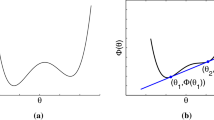Abstract
Conewise linear elastic (CLE) materials are proposed as the proper generalization to two and three dimensions of one-dimensionalbimodular models. The basic elements of classical smooth elasticity are extended tononsmooth (or piecewise smooth) elasticity. Firstly, a necessary and sufficient condition for a stress-strain law to becontinous across the interface of the tension and compression subdomains is established. Secondly, a sufficient condition for the strain energy function to be strictlyconvex is derived. Thirdly, the representations of the energy function, stress-strain law and elasticity tensor are obtained fororthotropic, transverse isotropic andisotropic CLE materials. Finally, the previous results are specialized to apiecewise linear stress-strain law and it is found out that the pieces must be polyhedral convex cones, thus the CLE name.
Similar content being viewed by others
References
P. Alart, Critères d'injectivité et de surjectivité pour certaines applications deR Ndans lui-même; Application à la mécanique des contacts.RAIRO (1992).
S.A. Ambartsumyan, The axisymmetric problem of circular cylindrical shell made of materials with different stiffnesses in tension and compression.Izv. Akad. Nauk. SSSR Mekh. 4 (1965) 77–85.
S.A. Ambartsumyan, Basic equations and relations of the different modulus theory of elasticity of an anisotropic body.Mechanics of Solids 4 (1969) 48–56.
S.A. Ambartsumyan and A.A. Khachatryan, The basic equations of the theory of elasticity for materials with different stiffnesses in tension and compression.Mechanics of Solids 1 (1966) 29–34.
C.W. Bert, Model for fibrous composites with different properties in tension and compression.J. of Eng. Mat. & Tech. 99 (1977) 344–349.
J.P. Boehler, Lois de comportement des milieux continus.J. de Mécanique 17 (1978) 153–190.
J.L. Chaboche, On the description of damage induced anisotropy and active/passive damage effect. In J.W. Ju, D. Krajcinovic and H.L. Schreyer (eds),Damage Mechanics in Engineering Materials. AMD/ASME (1990) pp. 153–166.
P.G. Ciarlet,Mathematical Elasticity. Elsevier (1988).
F.H. Clarke,Optimization and Nonsmooth Analysis. John Wiley & Sons (1983).
H. Costa-Mattos, M. Fremond and E.N. Mamiya, A simple model of the mechanical behaviour of ceramic-like materials.Int. J. of Solids and Structures 29 (1992) 3185–3200.
A. Curnier,Méthodes numériques en mécanique des solides. PPUR (1993).
G.P.Del Piero, Some properties of the set of fourth-order tensors, with application to elasticity.J. of Elasticity 9 (1979) 245–261.
A.E. Green and J.Z. Mkrtichian, Elastic solids with different moduli in tension and compression.J. of Elasticity 7 (1977) 369–386.
M.E. Gurtin,An Introduction to Continuum Mechanics. Academic Press (1981).
P.R. Halmos,Finite-Dimensional Vector Spaces. Springer-Verlag (1974).
H. Horii and S. Nemat-Nasser, Overall moduli of Solids with microcracks: load induced anisotropy.J. of the Mechanics and Physics of Solids 32 (1983) 155–171.
R.M. Jones, Stress-strain relations for materials with different moduli in tension and compression.AIAA Journal 15 (1977) 16–23.
N. Kamiya, Bimodulus thermoelasticity considering temperature dependent material properties. In C.W. Bert (ed.),Mechanics of Bimodulus Materials. AMD/ASME (1979) pp. 29–37.
M. Kojima and R. Saigal, On the relationship between conditions that ensure a PL mapping is a homeomorphism.Mathematics of Operations Research 5 (1980).
I.-S. Liu, On representations of anisotropic invariants.Int. J. Engng. Sci. 20 (1982) 1099–1109.
M. Lucchesi, D.R. Owen and P. Podio-Guidugli, Materials with elastic range: A theory with a view toward applications. Part III, Approximate constitutive relations.Archives of Rational Mechanics and Analysis 117 (1992) 53–96.
J.E. Marsden and T.J.R. Hughes,Mathematical Foundations of Elasticity. Prentice-Hall (1983).
J. Mazars, Y. Berthaud and S. Ramtani, The unilateral behaviour of damaged concrete.Eng. Fract. Mech. 35 (1990) 629–635.
G. Medri, A non linear elastic model for isotropic material with different behaviour in tension and compression.J. of Eng. Mat. & Tech. 104 (1982) 22–27.
R.C. Novak and C.W. Bert, Theoretical and experimental basis for more precise elastic properties of epoxy.J. of Composite Materials 2 (1968) 506–508.
Z. Rigbi, Some thoughts concerning the existence or otherwise of an isotropic bimodulus material.J. of Eng. Mat. & Tech. 99 (1980) 383–384.
R.T. Rockafellar,Convex Analysis. Princeton University Press (1970).
E. Sacco and J.N. Reddy, A constitutive model for bimodular materials with an application to plate bending.J. of Applied Mechanics 59 (1992) 220–221.
G.S. Shapiro, Deformation of bodies with different tension and compression stiffnesses.Mechanics of Solids 1 (1966) 85–86.
D.A. Spence and J.Z. Mkrtichian, The Boussinesq problem for a material with different moduli in tension and compression.J. of Mechanics and Applied Mathematics 30 (1977) 449–466.
A.J.M. Spencer, The formulation of constitutive equations for anisotropic solids. In J.P. Boehler (ed.),Mechanical Behaviour of Anisotropic Solids. Martinus Nijhoff Publishers, The Hague (1982) pp. 2–26.
F. Tabaddor, A survey of constitutive equations of bimodulus elastic materials. In C.W. Bert (ed.),Mechanics of Bimodulus Materials. AMD/ASME (1979) pp. 1–15.
K. Vijayakumar and K.P. Rao, Stress-strain relations for composites with different stiffnesses in tension and compression.Comp. Mech. 2 (1987) 167–175.
Author information
Authors and Affiliations
Rights and permissions
About this article
Cite this article
Curnier, A., He, QC. & Zysset, P. Conewise linear elastic materials. J Elasticity 37, 1–38 (1994). https://doi.org/10.1007/BF00043417
Received:
Revised:
Issue Date:
DOI: https://doi.org/10.1007/BF00043417




